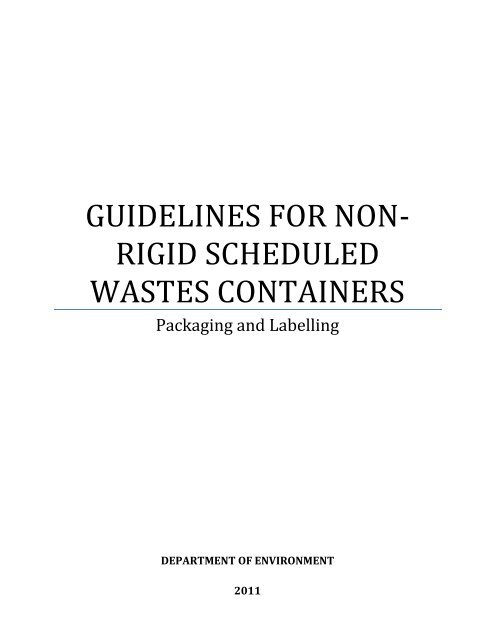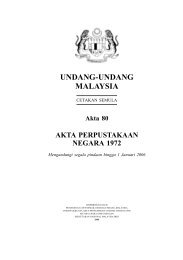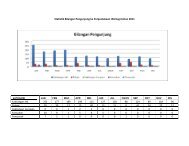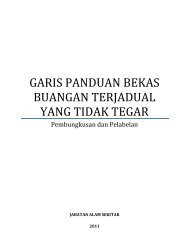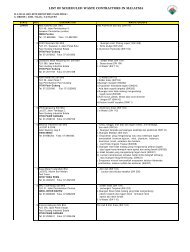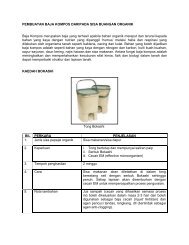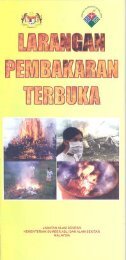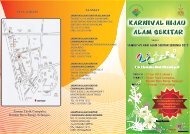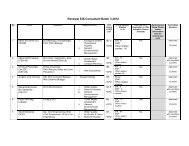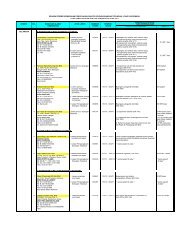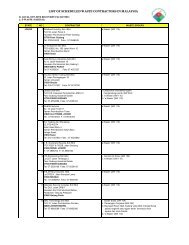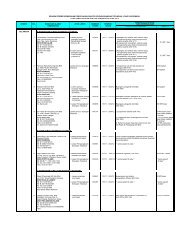Guidelines for Non Rigid Scheduled Wastes Containers : Packaging
Guidelines for Non Rigid Scheduled Wastes Containers : Packaging
Guidelines for Non Rigid Scheduled Wastes Containers : Packaging
Create successful ePaper yourself
Turn your PDF publications into a flip-book with our unique Google optimized e-Paper software.
GUIDELINES FOR NON-<br />
RIGID SCHEDULED<br />
WASTES CONTAINERS<br />
<strong>Packaging</strong> and Labelling<br />
DEPARTMENT OF ENVIRONMENT<br />
2011
CONTENTS<br />
Foreword 1<br />
Introduction 2<br />
Scope 2<br />
Identification of Waste Characteristics 2<br />
Selection of <strong>Containers</strong> 4<br />
Labelling of <strong>Containers</strong> 5<br />
Placing/Filling/Packing of Incompatible <strong>Scheduled</strong> <strong>Wastes</strong> in <strong>Containers</strong> 7<br />
Managing of <strong>Containers</strong> Containing <strong>Scheduled</strong> <strong>Wastes</strong> 7<br />
Storage Area Inspection 8<br />
References 15<br />
Appendices<br />
Appendix 1: <strong>Scheduled</strong> <strong>Wastes</strong> of Potential Incompatibility 9<br />
Appendix 2: Compatibility Chart <strong>for</strong> Chemical Mixtures 11<br />
Appendix 3: Waste Card 12<br />
Appendix 4: <strong>Scheduled</strong> <strong>Wastes</strong> Storage Inspection Checklist 14
1<br />
<strong>Guidelines</strong> <strong>for</strong> <strong>Non</strong>-<strong>Rigid</strong> <strong>Scheduled</strong> <strong>Wastes</strong><br />
<strong>Containers</strong>: <strong>Packaging</strong> and Labelling<br />
GUIDELINES FOR NON-RIGID SCHEDULED WASTES<br />
CONTAINERS: PACKAGING AND LABELLING<br />
1.0 INTRODUCTION<br />
1.1 <strong>Scheduled</strong> wastes due to its characteristics can pose risks to human<br />
health and the environment. Hence, there is a need to properly handle<br />
the wastes. To facilitate the proper handling of scheduled wastes,<br />
in<strong>for</strong>mation about the hazards associated with the wastes must be<br />
communicated through proper labels to be used by wastes handlers.<br />
1.2 To ensure that the wastes are safely handled, suitable containers are<br />
also needed to be used by the waste generators. It is the responsibility<br />
of the waste generators to ensure that scheduled wastes are packed<br />
based on the composition in a manner suitable <strong>for</strong> handling, storage<br />
and transportation.<br />
1.3 To facilitate the waste generators to choose suitable containers and<br />
proper labelling, these guidelines are prepared in accordance to the<br />
requirements of Regulation 8(2) of the Environmental Quality<br />
(<strong>Scheduled</strong> <strong>Wastes</strong>) Regulations 2005 which has been en<strong>for</strong>ced since<br />
15 th August 2005.<br />
2.0 SCOPE<br />
2.1 These guidelines describe the selection of proper containers and<br />
labels to be used by the waste generators in managing their scheduled<br />
wastes from the time a waste is generated and placed/filled/packed in<br />
a container, until the waste-filled container is transferred off site <strong>for</strong><br />
recovery and/or final disposal.<br />
2.2 These guidelines are only applicable to non-rigid scheduled wastes<br />
containers such as jumbo bags. For labelling and packaging <strong>for</strong> rigid<br />
scheduled wastes containers, please refer to Malaysia Standard MS<br />
2304:2010.<br />
3.0 IDENTIFICATION OF WASTE CHARACTERISTICS<br />
3.1 The scheduled wastes characteristics shall be identified by the<br />
following methods:<br />
3.1.1 Sampling and analysing the scheduled wastes<br />
(a) The scheduled waste shall be sampled and analysed to<br />
identify the hazards and contaminant in the waste.
2<br />
<strong>Guidelines</strong> <strong>for</strong> <strong>Non</strong>-<strong>Rigid</strong> <strong>Scheduled</strong> <strong>Wastes</strong><br />
<strong>Containers</strong>: <strong>Packaging</strong> and Labelling<br />
(b) During the sampling and analysis of the waste, the Material<br />
Safety Data Sheet (MSDS) / Chemical Safety Data Sheet<br />
(CSDS) / Safety Data Sheet (SDS) and/or waste card<br />
should be referred to, if it is available in order to get their<br />
hazards properties such as physical hazards, human health<br />
hazards and environmental hazards including any special<br />
protection requirement needed.<br />
3.1.2 Identification based on process knowledge or history<br />
Generally, the waste generated from a process may exhibit<br />
some similar hazardous characteristics of the raw materials or<br />
chemicals or substances used. Any changes in the process line<br />
or during the production process may lead to changes and<br />
alteration of the composition of the waste generated. The<br />
changes in the process shall be notified to, and be made aware<br />
of, by the relevant authorities.<br />
3.2 The scheduled wastes may have the following hazardous<br />
characteristics:<br />
(a) corrosive substances;<br />
(b) explosive substances;<br />
(c) infectious substances;<br />
(d) inflammable liquids;<br />
(e) inflammable solids;<br />
(f) organic peroxides;<br />
(g) oxidising substances;<br />
(h) solid: spontaneously combustible;<br />
(i) solid: dangerous when wet;<br />
(j) toxic substances; and<br />
(k) mixture of miscellaneous dangerous substances.<br />
Sufficient precaution shall be given when dealing with scheduled<br />
wastes having the above characteristics.
<strong>Guidelines</strong> <strong>for</strong> <strong>Non</strong>-<strong>Rigid</strong> <strong>Scheduled</strong> <strong>Wastes</strong><br />
<strong>Containers</strong>: <strong>Packaging</strong> and Labelling<br />
5.5 In<strong>for</strong>mation to be included in the label <strong>for</strong> scheduled wastes containers:<br />
(a) The date when the scheduled wastes are first generated; and<br />
(b) The name, address and telephone number of the scheduled waste<br />
generator.<br />
No person is allowed to alter the identification number and the labels<br />
and markings.<br />
5.6 Figure 2 is an example of label <strong>for</strong> the scheduled wastes<br />
containers.<br />
Waste code :<br />
Waste name :<br />
Date generated :<br />
Name of waste<br />
:<br />
generator<br />
Address and<br />
telephone :<br />
number<br />
MIXTURE OF MISCELLANEOUS DANGEROUS SUBSTANCES<br />
(WASTE)<br />
Figure 2: Example of label <strong>for</strong> scheduled wastes container<br />
5.7 All labels shall be able to withstand open weather exposure without a<br />
substantial reduction in effectiveness.<br />
5.8 Label shall be placed on a background of contrasting colour.<br />
5.9 In the case of waste capable of causing two or more hazards, all the<br />
hazards must be clearly identified and the waste shall be labelled<br />
accordingly.<br />
5
6<br />
<strong>Guidelines</strong> <strong>for</strong> <strong>Non</strong>-<strong>Rigid</strong> <strong>Scheduled</strong> <strong>Wastes</strong><br />
<strong>Containers</strong>: <strong>Packaging</strong> and Labelling<br />
6.0 PLACING/FILLING/PACKING OF INCOMPATIBLE SCHEDULED<br />
WASTES IN CONTAINERS<br />
6.1 Incompatible scheduled wastes shall be placed/filled/packed in<br />
separate containers. Incompatible scheduled wastes when mixed will<br />
produce hazardous situations. The indication of some of the hazards<br />
that can be expected if mixing of incompatible wastes took place is as<br />
shown in Fourth Schedule, Regulation 2 of the Environmental Quality<br />
(<strong>Scheduled</strong> <strong>Wastes</strong>) Regulations 2005 as in Appendix 1.<br />
6.2 Since the waste generated from a process may exhibit some similar<br />
hazardous characteristics of the raw materials or chemicals or<br />
substances used, the Compatibility Chart <strong>for</strong> Chemical Mixtures as in<br />
Appendix 2 can be used to indicate the hazards that can arise from<br />
mixing of incompatible chemical wastes.<br />
7.0 MANAGING OF CONTAINERS CONTAINING SCHEDULED WASTES<br />
7.1 <strong>Containers</strong> containing scheduled wastes shall be properly managed to<br />
prevent spills and leakages. <strong>Containers</strong> containing scheduled wastes<br />
shall be placed on wooden pallet and can only be allowed to be<br />
stacked not more than 3 tiers on crate storage.<br />
7.2 Incompatible scheduled wastes shall be stored in separate containers,<br />
and such containers shall be placed in separate secondary<br />
containment area.<br />
Secondary containment area is a liquid-tight barrier that will contain<br />
hazardous materials that are released from a container.<br />
7.3 As precautions, non-rigid scheduled wastes containers shall be kept<br />
in a place where the floor is covered by concrete or other suitable<br />
material. The storage place should be sheltered or roofed or covered<br />
with suitable covering material. The storage area shall be properly<br />
managed in such a way to prevent rain water or surface water from<br />
entering the storage area.<br />
7.4 The waste generator shall provide in<strong>for</strong>mation (waste card) as in<br />
Appendix 3 <strong>for</strong> each type of scheduled wastes and shall be made<br />
aware to all relevant employees and parties.
<strong>Scheduled</strong> <strong>Wastes</strong> of Potential Incompatibility<br />
8<br />
<strong>Guidelines</strong> <strong>for</strong> <strong>Non</strong>-<strong>Rigid</strong> <strong>Scheduled</strong> <strong>Wastes</strong><br />
<strong>Containers</strong>: <strong>Packaging</strong> and Labelling<br />
Appendix 1<br />
The mixing of a waste in Group A with a waste in Group B may have the following potential<br />
consequences:<br />
Group 1-A Group 1-B<br />
Alkaline caustic liquids Acid sludge<br />
Alkaline cleaner Chemical cleaners<br />
Alkaline corrosive liquid Electrolyte, acid<br />
Caustic wastewater Etching acid, liquid or solvent<br />
Lime sludge and other corrosive Pickling liquor and other corrosive acid<br />
alkalies Spent acid<br />
Spent mixed acid<br />
Potential consequences: Heat generation, violent reaction<br />
Group 2-A Group 2-B<br />
Asbestos Solvents<br />
Berryllium Explosives<br />
Unrinsed pesticide containers Petroleum<br />
Pesticides Oil and other flammable wastes<br />
Potential consequences: Release of toxic substances in case of fire or explosion<br />
Group 3-A Group 3-B<br />
Aluminium Any waste in Group 1-A or 1-B<br />
Berryllium<br />
Calcium<br />
Lithium<br />
Magnesium<br />
Potassium<br />
Sodium<br />
Zinc powder and other reactive<br />
metals and metal hydrides<br />
Potential consequences: Fire or explosion; generation of flammable hydrogen gas<br />
Group 4-A Group 4-B<br />
Alcohols Any concentrated waste in Group 1-A or 1-B<br />
Calcium<br />
Lithium<br />
Metal hydrides<br />
Potassium<br />
Sodium<br />
Water reactive wastes<br />
Potential consequences: Fire, explosion or heat generation; generation of flammable toxic gases
Group 5-A Group 5-B<br />
9<br />
<strong>Guidelines</strong> <strong>for</strong> <strong>Non</strong>-<strong>Rigid</strong> <strong>Scheduled</strong> <strong>Wastes</strong><br />
<strong>Containers</strong>: <strong>Packaging</strong> and Labelling<br />
Alcohols Concentrated Group 1-A or 1-B wastes<br />
Aldehydes Group 3-A wastes<br />
Halogenated hydrocarbons<br />
Nitrated hydrocarbons and other<br />
reactive organic compounds and<br />
solvents<br />
Unsaturated hydrocarbons<br />
Potential consequences: Fire, explosion or violent reaction<br />
Group 6-A Group 6-B<br />
Spent cyanide and sulphide Group 1-B wastes<br />
solution<br />
Potential consequences: Generation of toxic hydrogen cyanide or hydrogen sulphide gas<br />
Group 7-A Group 7-B<br />
Chlorates and other strong oxidizers Organic acids<br />
Chlorites Group 2-B wastes<br />
Chromic acid Group 3-B wastes<br />
Hypochlorites Group 5-A wastes and other<br />
Nitrates flammable and combustible wastes<br />
Nitric acid<br />
Perchlorates<br />
Permanganates<br />
Peroxides<br />
Potential consequences: Fire, explosion or violent reaction
A. Properties<br />
1. Category of waste<br />
2. Origin<br />
- according to the First Schedule<br />
11<br />
<strong>Guidelines</strong> <strong>for</strong> <strong>Non</strong>-<strong>Rigid</strong> <strong>Scheduled</strong> <strong>Wastes</strong><br />
<strong>Containers</strong>: <strong>Packaging</strong> and Labelling<br />
Appendix 3<br />
- State from which process, activity, occurrence, etc. the waste is generated<br />
3. Physical properties of waste<br />
4. Risks<br />
- Flashpoint<br />
- Boiling point<br />
o C<br />
o C<br />
- Consistency at room temperature (gas, liquid, sludge, solid)<br />
- Vapours lighter/heavier than air<br />
- Solubility in water<br />
- Waste lighter/heavier than water<br />
- by inhalation<br />
- by oral intake<br />
B. Handling of Waste<br />
- by dermal contact<br />
1. Personal protection equipment<br />
- Gloves, goggles, face shield etc.<br />
2. Procedures/Precautions in handling, packaging transporting and storage<br />
3. Appropriate label<br />
- Labels <strong>for</strong> the containers<br />
4. Recommended Method of Disposal<br />
C. Precautions in case of spill or accidental discharge causing personal injury<br />
1. In case of inhalation of fumes or oral intake<br />
- Symptoms of intoxication<br />
- Appropriate first aid<br />
- <strong>Guidelines</strong> <strong>for</strong> the physician


